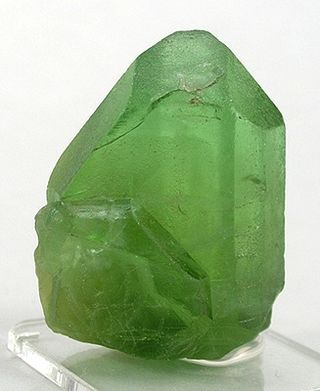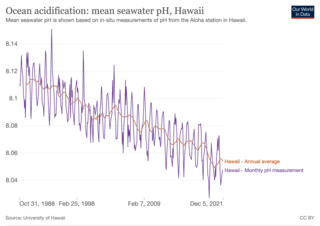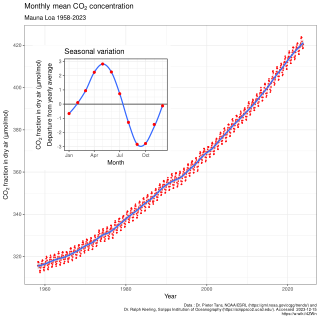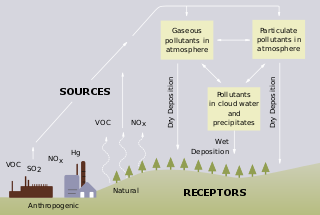Related Research Articles

Carbon dioxide is a chemical compound with the chemical formula CO2. It is made up of molecules that each have one carbon atom covalently double bonded to two oxygen atoms. It is found in the gas state at room temperature, and as the source of available carbon in the carbon cycle, atmospheric CO2 is the primary carbon source for life on Earth. In the air, carbon dioxide is transparent to visible light but absorbs infrared radiation, acting as a greenhouse gas. Carbon dioxide is soluble in water and is found in groundwater, lakes, ice caps, and seawater. When carbon dioxide dissolves in water, it forms carbonate and mainly bicarbonate, which causes ocean acidification as atmospheric CO2 levels increase.

The mineral olivine is a magnesium iron silicate with the chemical formula (Mg,Fe)2SiO4. It is a type of nesosilicate or orthosilicate. The primary component of the Earth's upper mantle, it is a common mineral in Earth's subsurface, but weathers quickly on the surface. For this reason, olivine has been proposed as a good candidate for accelerated weathering to sequester carbon dioxide from the Earth's oceans and atmosphere, as part of climate change mitigation. Olivine also has many other historical uses, such as the gemstone peridot, as well as industrial applications like metalworking processes.

The carbon cycle is that part of the biogeochemical cycle by which carbon is exchanged among the biosphere, pedosphere, geosphere, hydrosphere, and atmosphere of Earth. Other major biogeochemical cycles include the nitrogen cycle and the water cycle. Carbon is the main component of biological compounds as well as a major component of many minerals such as limestone. The carbon cycle comprises a sequence of events that are key to making Earth capable of sustaining life. It describes the movement of carbon as it is recycled and reused throughout the biosphere, as well as long-term processes of carbon sequestration (storage) to and release from carbon sinks.
A hydrogen ion is created when a hydrogen atom loses an electron. A positively charged hydrogen ion (or proton) can readily combine with other particles and therefore is only seen isolated when it is in a gaseous state or a nearly particle-free space. Due to its extremely high charge density of approximately 2×1010 times that of a sodium ion, the bare hydrogen ion cannot exist freely in solution as it readily hydrates, i.e., bonds quickly. The hydrogen ion is recommended by IUPAC as a general term for all ions of hydrogen and its isotopes. Depending on the charge of the ion, two different classes can be distinguished: positively charged ions and negatively charged ions.

Alkalinity (from Arabic: القلوية, romanized: al-qaly, lit. 'ashes of the saltwort') is the capacity of water to resist acidification. It should not be confused with basicity, which is an absolute measurement on the pH scale. Alkalinity is the strength of a buffer solution composed of weak acids and their conjugate bases. It is measured by titrating the solution with an acid such as HCl until its pH changes abruptly, or it reaches a known endpoint where that happens. Alkalinity is expressed in units of concentration, such as meq/L (milliequivalents per liter), μeq/kg (microequivalents per kilogram), or mg/L CaCO3 (milligrams per liter of calcium carbonate). Each of these measurements corresponds to an amount of acid added as a titrant.

In oceanic biogeochemistry, the solubility pump is a physico-chemical process that transports carbon as dissolved inorganic carbon (DIC) from the ocean's surface to its interior.

Ocean acidification is the ongoing decrease in the pH of the Earth's ocean. Between 1950 and 2020, the average pH of the ocean surface fell from approximately 8.15 to 8.05. Carbon dioxide emissions from human activities are the primary cause of ocean acidification, with atmospheric carbon dioxide levels exceeding 410 ppm. CO2 from the atmosphere is absorbed by the oceans. This chemical reaction produces carbonic acid which dissociates into a bicarbonate ion and a hydrogen ion. The presence of free hydrogen ions lowers the pH of the ocean, increasing acidity. Marine calcifying organisms, such as mollusks and corals, are especially vulnerable because they rely on calcium carbonate to build shells and skeletons.

Carbon sequestration is the process of storing carbon in a carbon pool. It plays a crucial role in mitigating climate change by reducing the amount of carbon dioxide in the atmosphere. There are two main types of carbon sequestration: biologic and geologic. Biologic carbon sequestration is a naturally occurring process as part of the carbon cycle. Humans can enhance it through deliberate actions and use of technology. Carbon dioxide is naturally captured from the atmosphere through biological, chemical, and physical processes. These processes can be accelerated for example through changes in land use and agricultural practices, called carbon farming. Artificial processes have also been devised to produce similar effects. This approach is called carbon capture and storage. It involves using technology to capture and sequester (store) CO
2 that is produced from human activities underground or under the sea bed.

The Virgin Earth Challenge was a competition offering a $25 million prize for whoever could demonstrate a commercially viable design which results in the permanent removal of greenhouse gases out of the Earth's atmosphere to contribute materially in global warming avoidance. The prize was conceived by Richard Branson, and was announced in London on 9 February 2007 by Branson and former US Vice President Al Gore.

In Earth's atmosphere, carbon dioxide is a trace gas that plays an integral part in the greenhouse effect, carbon cycle, photosynthesis and oceanic carbon cycle. It is one of several greenhouse gases in the atmosphere of Earth. The current global average concentration of carbon dioxide (CO2) in the atmosphere is 421 ppm as of May 2022 (0.04%). This is an increase of 50% since the start of the Industrial Revolution, up from 280 ppm during the 10,000 years prior to the mid-18th century. The increase is due to human activity. Burning fossil fuels is the main cause of these increased CO2 concentrations and also the main cause of climate change. Other large sources of CO2 from human activities include cement production, deforestation, and biomass burning.

The carbonate–silicate geochemical cycle, also known as the inorganic carbon cycle, describes the long-term transformation of silicate rocks to carbonate rocks by weathering and sedimentation, and the transformation of carbonate rocks back into silicate rocks by metamorphism and volcanism. Carbon dioxide is removed from the atmosphere during burial of weathered minerals and returned to the atmosphere through volcanism. On million-year time scales, the carbonate-silicate cycle is a key factor in controlling Earth's climate because it regulates carbon dioxide levels and therefore global temperature.

Carbon dioxide removal (CDR) is a process in which carbon dioxide is removed from the atmosphere by deliberate human activities and durably stored in geological, terrestrial, or ocean reservoirs, or in products. This process is also known as carbon removal, greenhouse gas removal or negative emissions. CDR is more and more often integrated into climate policy, as an element of climate change mitigation strategies. Achieving net zero emissions will require first and foremost deep and sustained cuts in emissions, and then—in addition—the use of CDR. In the future, CDR may be able to counterbalance emissions that are technically difficult to eliminate, such as some agricultural and industrial emissions.
Enhanced weathering, also termed ocean alkalinity enhancement when proposed for carbon credit systems, is a process that aims to accelerate the natural weathering by spreading finely ground silicate rock, such as basalt, onto surfaces which speeds up chemical reactions between rocks, water, and air. It also removes carbon dioxide from the atmosphere, permanently storing it in solid carbonate minerals or ocean alkalinity. The latter also slows ocean acidification.
The atmospheric carbon cycle accounts for the exchange of gaseous carbon compounds, primarily carbon dioxide, between Earth's atmosphere, the oceans, and the terrestrial biosphere. It is one of the faster components of the planet's overall carbon cycle, supporting the exchange of more than 200 billion tons of carbon in and out of the atmosphere throughout the course of each year. Atmospheric concentrations of CO2 remain stable over longer timescales only when there exists a balance between these two flows. Methane, Carbon monoxide (CO), and other man-made compounds are present in smaller concentrations and are also part of the atmospheric carbon cycle.

The oceanic carbon cycle is composed of processes that exchange carbon between various pools within the ocean as well as between the atmosphere, Earth interior, and the seafloor. The carbon cycle is a result of many interacting forces across multiple time and space scales that circulates carbon around the planet, ensuring that carbon is available globally. The Oceanic carbon cycle is a central process to the global carbon cycle and contains both inorganic carbon and organic carbon. Part of the marine carbon cycle transforms carbon between non-living and living matter.

Freshwater acidification occurs when acidic inputs enter a body of fresh water through the weathering of rocks, invasion of acidifying gas, or by the reduction of acid anions, like sulfate and nitrate within a lake. Freshwater acidification is primarily caused by sulfur oxides (SOx) and nitrogen oxides (NOx) entering the water from atmospheric depositions and soil leaching. Carbonic acid and dissolved carbon dioxide can also enter freshwaters, in a similar manner associated with runoff, through carbon dioxide-rich soils. Runoff that contains these compounds may incorporate acidifying hydrogen ions and inorganic aluminum, which can be toxic to marine organisms. Acid rain is also a contributor to freshwater acidification. It is created when SOx and NOx react with water, oxygen, and other oxidants within the clouds.
Carbon rift is a theory attributing the input and output of carbon into the environment to human capitalistic systems. This is a derivative of Karl Marx's concept of metabolic rift. In practical terms, increased commodity production demands that greater levels of carbon dioxide (or CO2) be emitted into the biosphere via fossil fuel consumption. Carbon rift theory states that this ultimately disrupts the natural carbon cycle and that this "rift" has adverse effects on nearly every aspect of life. Many of the specifics regarding how this metabolic carbon rift interacts with capitalism are proposed by Brett Clark and Richard York in a 2005 article titled "Carbon Metabolism: Global capitalism, climate change, and the biospheric rift" in the journal Theory and Society. Researchers such as Jean P. Sapinski of the University of Oregon claim that, despite increased interest in closing the carbon rift, it is projected that as long as capitalism continues, there is little hope of reducing the rift.

Marine biogenic calcification is the production of calcium carbonate by organisms in the global ocean.
Direct deep-sea carbon dioxide injection was a (now abandoned) technology proposal with the aim to remove carbon dioxide from the atmosphere by direct injection into the deep ocean to store it there for centuries. At the ocean bottom, the pressures would be great enough for CO2 to be in its liquid phase. The idea behind ocean injection was to have stable, stationary pools of CO2 at the ocean floor. The ocean could potentially hold over a thousand billion tons of CO2. However, the interest in this avenue of carbon storage has much reduced since about 2001 because of concerns about the unknown impacts on marine life, high costs and concerns about its stability or permanence.

The Arctic ocean covers an area of 14,056,000 square kilometers, and supports a diverse and important socioeconomic food web of organisms, despite its average water temperature being 32 degrees Fahrenheit. Over the last three decades, the Arctic Ocean has experienced drastic changes due to climate change. One of the changes is in the acidity levels of the ocean, which have been consistently increasing at twice the rate of the Pacific and Atlantic oceans. Arctic Ocean acidification is a result of feedback from climate system mechanisms, and is having negative impacts on Arctic Ocean ecosystems and the organisms that live within them.
References
- 1 2 3 Hopper, Nate; Lokting, Britta; Kavin, Kim (16 August 2022). "15 Young Founders Rethinking Everything From Artificial Intelligence to Carbon Removal, Sustainable Fashion to...Pizza!". Entrepreneur . ISSN 0163-3341 . Retrieved 19 October 2022.
- 1 2 3 4 5 Temple, James (June 22, 2020). "A Caribbean beach could offer a crucial test in the fight to slow climate change". MIT Technology Review . Retrieved 2020-11-06.
- ↑ Ratcliffe, Verity; Ma, Michelle (September 28, 2023). "How Seeding the Oceans With Minerals Could Grab Carbon From the Atmosphere". Bloomberg. Retrieved 14 March 2024.
- 1 2 3 4 5 6 7 8 9 Peters, Adele (2020-05-29). "Ever been to a green sand beach? The newest geohack to fight climate change". Fast Company . Retrieved 2020-11-06.
- ↑ Merrill, Kitty (May 26, 2022). "Dredge Spoil + Olivine = A Nourished Beach In North Sea". 27east.com. Retrieved 14 March 2024.
- ↑ Kozak, Catharine (November 22, 2022). "Carbon capture project proposed for ocean waters off Duck". Coastal Review. Retrieved 14 March 2024.
- ↑ Fleming, Amy (23 June 2021). "Cloud spraying and hurricane slaying: how ocean geoengineering became the frontier of the climate crisis". The Guardian. Retrieved 20 October 2022.
- ↑ Ratcliffe, Verity; Ma, Michelle (September 28, 2023). "How Seeding the Oceans With Minerals Could Grab Carbon From the Atmosphere". Bloomberg. Retrieved 14 March 2024.
- 1 2 3 Delbert, Caroline (2020-06-11). "How This Strange Green Sand Could Reverse Climate Change". Popular Mechanics. Retrieved 2020-11-06.
- ↑ Purchia, Robyn (16 July 2022). "Let's keep the climate restoration movement growing". San Francisco Examiner . Retrieved 21 October 2022.
- ↑ Palmer, Phillip (20 October 2021). "Cutting-edge technology battles climate change by using sand to pull carbon dioxide from atmosphere". ABC7 San Francisco. Retrieved 19 October 2022.
- 1 2 Temple, James (30 March 2022). "Why using the oceans to suck up CO2 might not be as easy as hoped". MIT Technology Review . Retrieved 20 October 2022.
- ↑ "Solving for Zero". IMDB. Retrieved 14 March 2024.
- 1 2 Merrill, Kitty (26 May 2022). "Dredge Spoil + Olivine = A Nourished Beach In North Sea". 27East.com. Southampton Press. Retrieved 19 October 2022.
- ↑ Agard, Sade (26 August 2022). "The mineral that could remove 1 billion tonnes of CO2 from the atmosphere and protect shorelines and oceans too- but will it go to scale? Interesting Engineering". Interesting Engineering. Interestingengineering.com. Retrieved 20 October 2022.
- ↑ Hilser, Harry; Cox, Emily; Draiby, Andrea; Moreau, Cheyenne; Hiraldo, Lia; Walworth, Nathan; Winks, Lewis (May 22, 2022). "Localized governance of carbon dioxide removal in Small Island Developing States". SSRN. Retrieved 14 March 2024.
- ↑ Yeung, Peter (21 December 2021). "Could crushed rocks absorb enough carbon to curb global warming? A little-examined form of geoengineering takes what rocks normally do—lock up carbon—and spreads it through the oceans". National Geographic. Archived from the original on December 21, 2021. Retrieved 20 October 2022.